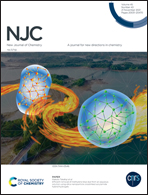Efficient absorption of ammonia with dialkylphosphate-based ionic liquids†
Abstract
Ammonia (NH3) absorption has attracted much attention due to serious environmental pollution caused by ammonia in recent years. In this paper, the solubilities of ammonia (pressure–temperature–composition (pTx) data) in five dialkylphosphate-based ionic liquids (ILs) were determined at different temperatures (303.15 K–333.15 K) and pressures (about 0.1 MPa–0.6 MPa). It was found that the solubilities of ammonia increased with decreasing temperature and increasing pressure. NH3 dissolution could be improved in ILs with longer side chain lengths in the imidazolium ring of cations and shorter side chain lengths in anions, which could be related to the densities and viscosities of the ILs. Moreover, based on NH3 solubility data, Henry's law constants were obtained using the Peng–Robinson (PR) equation of state. Consequently thermodynamic properties including solution enthalpy ΔsolH, solution entropy ΔsolS and solution Gibbs free energy ΔsolG were calculated. The results indicated that higher absolute values of ΔsolH could generally demonstrate stronger interactions between NH3 and ILs, which corresponds to the smaller Henry's law constants and higher solubility of NH3 in the ILs. In addition these ILs can exhibit excellent reversibility, indicating that these ILs can be regarded as potential absorbents for NH3 in chemical industry processes.



 Please wait while we load your content...
Please wait while we load your content...